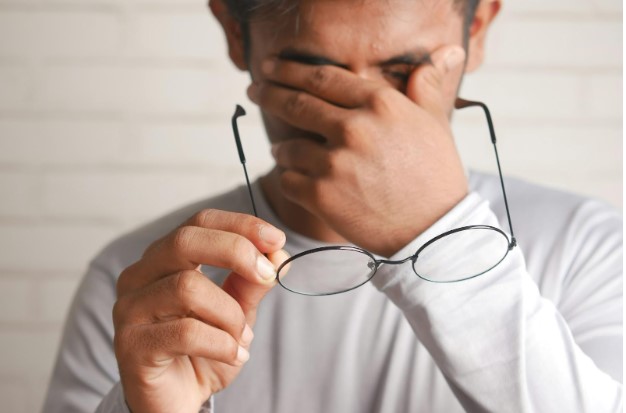In today’s digital age, where screens dominate our work and leisure activities, protecting our vision has become more important than ever. Prolonged exposure to digital screens can lead to eye strain, fatigue, and other vision-related issues. Fortunately, there are several strategies you can adopt to minimize eye strain and maintain healthy vision. In this blog post, we’ll explore some effective tips for reducing eye strain from screen time.

Understanding Eye Strain
Before diving into the tips, let’s first grasp what eye strain is and why it occurs. Eye strain, also known as computer vision syndrome (CVS), is a common condition resulting from prolonged use of digital screens like computers, smartphones, tablets, and televisions.
Symptoms include blurred vision, where objects may appear fuzzy or out of focus, dry or irritated eyes characterized by a feeling of grittiness or itchiness, headaches that range from mild discomfort to intense pain, neck and shoulder pain due to poor posture or muscle tension, difficulty focusing on tasks, and sensitivity to light, making it uncomfortable to work in brightly lit environments. These symptoms can significantly impact productivity, leading to decreased efficiency increased errors, and overall well-being if left unaddressed, experts from BlockBlueLight explain. Understanding the causes and symptoms of eye strain is essential for implementing effective strategies to minimize its effects and maintain healthy vision in the digital age.
Practice the 20-20-20 Rule
One of the simplest and most effective ways to reduce eye strain is by following the 20-20-20 rule. This rule suggests that for every 20 minutes of screen time, you should take a 20-second break and focus on something at least 20 feet away. This practice helps relax your eye muscles and prevents them from becoming strained due to prolonged screen exposure.
Adjust Screen Settings
Optimizing your screen settings can also contribute to reducing eye strain. Adjust the brightness, contrast, and font size of your screen to ensure comfortable viewing. A screen that is too bright or too dim can strain your eyes, so find a balance that works for you. Additionally, consider using blue light filter apps or glasses to minimize the harmful effects of blue light emitted by screens.
Maintain Proper Posture
Your posture plays a crucial role in preventing eye strain and overall physical discomfort. Sit at an ergonomic workstation with your screen at eye level and your back supported. Avoid slouching or leaning too close to the screen, as this can strain not just your eyes but also your neck and shoulders.
Take Regular Breaks
In addition to the 20-20-20 rule, make sure to take regular breaks from screen time. Engage in activities that allow your eyes to rest and relax, such as walking, stretching, or practicing eye exercises. These breaks not only reduce eye strain but also improve overall circulation and mental focus.
Blink Often and Stay Hydrated
Blinking is a natural mechanism that helps keep your eyes moist and prevents dryness, which is common during extended screen use. Make a conscious effort to blink more frequently while using digital devices. Additionally, stay hydrated by drinking plenty of water throughout the day, as dehydration can exacerbate dry eye symptoms.
Adjust Lighting Conditions
Proper lighting is essential for minimizing eye strain. Avoid glare and reflections on your screen by positioning your monitor away from windows or sources of bright light. Use curtains, blinds, or anti-glare screens to reduce glare. If necessary, use desk lamps with adjustable brightness to create a comfortable working environment.
Get Regular Eye Exams
Regular eye exams are crucial for maintaining optimal vision and detecting any underlying issues early on. By scheduling routine visits to an eye care professional, you can effectively monitor your eye health and address any concerns promptly. These exams allow your eye doctor to assess your vision and detect any changes that may indicate a need for corrective measures such as glasses or contact lenses.
Moreover, your eye doctor can recommend personalized strategies for reducing eye strain based on your specific needs and lifestyle. This may include prescribing specialized computer glasses, providing tips for ergonomic workstation setup, or suggesting eye exercises to alleviate strain and fatigue. Overall, regular eye exams play a vital role in ensuring healthy vision and preventing long-term complications related to eye strain and other vision-related issues.

In conclusion, protecting your vision from the harmful effects of screen time is achievable with the right strategies and habits. By incorporating the tips mentioned above into your daily routine, you can minimize eye strain, improve your overall eye health, and enhance your productivity and well-being. Remember, your eyes deserve the same care and attention as any other part of your body, so prioritize their health in the digital age.






